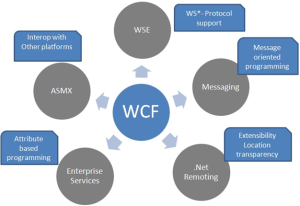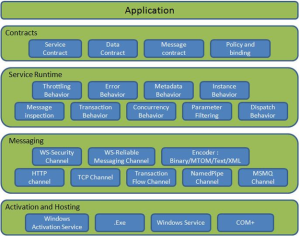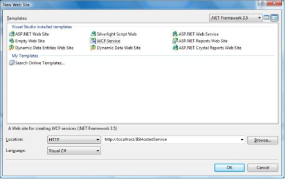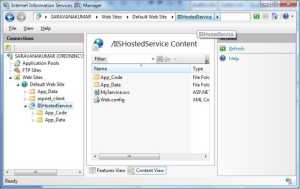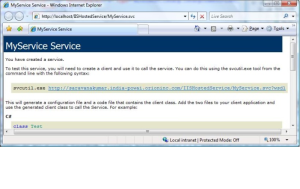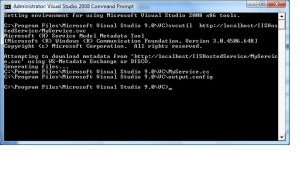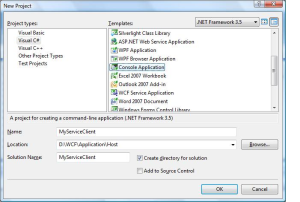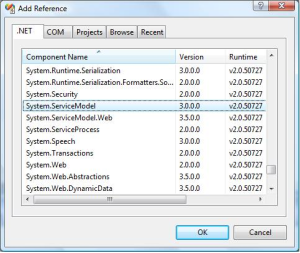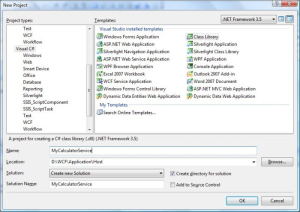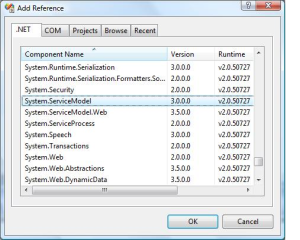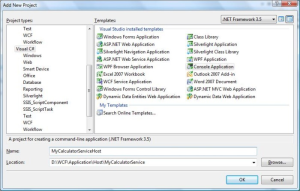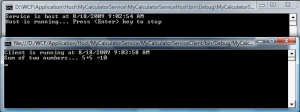Blog that contains articles about new technologies related or not with programming. I will describe and solves some problems that I encounter in my career. ASP .NET, AJAX, Javascript, C++, C# and SQL are some of the subjects that will appear.
02 April 2014
Register Framework 4 for IIS hosting
21 December 2013
Get factors of a number
int n = 10;
List<int> factors = new List<int>();
int max = Convert.ToInt32(Math.Sqrt(n));
for (int i = 1; i <= max; i++)
{
if (n % i == 0)
{
factors.Add(i);
if (i != max) // add square-root factors only once.
factors.Add(n / i);
}
}
Difference between String and string
1. String stands for System.String and it is a .NET Framework type.
2. string is a type in C#. System.String is a type in the CLR.
3. string is an alias for System.String in the C# language. Both of them are compiled to System.String in IL (Intermediate Language),
4. So there is no difference. Choose what you like and use that.
5. For code in C#, its prefer to use string as it's a C# type alias and well-known by C# programmers.
6. string is a reserved word, but String is just a class name.This means that 'string' cannot be used as a variable name by itself.
StringBuilder String = new StringBuilder(); // compiles
StringBuilder string = new StringBuilder(); // doesn't compile
7. If you really want a variable name called 'string' you can use @ as a prefix :
StringBuilder @string = new StringBuilder(); this applies to string also.
8. So String is not a keyword and it can be used as Identifier whereas string is a keyword and cannot be used as Identifier. And in function point of view both are same.
9. You can't use String without using System; but string can use without that namespace.
10. Static functions such as String.Format, String.Join, String.Concat, String.isNullOrWhitespace etc... are from String.
I can say the same about (int, System.Int32) etc..
20 December 2013
default Timeouts in c#
- Gets the time to wait while trying to establish a connection before terminating the attempt.
SqlCommand.CommandTimeout - 30 seconds
- Gets or sets the wait time before terminating the attempt to execute a command
Session Timeout - 20 mins
<system.web>
<SessionState timeout=”10”></SessionState>
Cookies per Domain - 20 - 1KB
PrimaryKey vs UniqueKey
Primary Key enforces uniqueness of the column on which they are defined.
Primary Key creates a clustered index on the column.
Primary Key does not allow Nulls.
CREATE TABLE EMP (eID INT NOT NULL PRIMARY KEY,
eName VARCHAR(100) NOT NULL)
Alter table with Primary Key:
ALTER TABLE EMP
ADD CONSTRAINT pk_eID PRIMARY KEY (eID)
Unique Key:
Unique Key enforces uniqueness of the column on which they are defined.
Unique Key creates a non-clustered index on the column.
Unique Key allows only one NULL Value.
Alter table to add unique constraint to column:
ALTER TABLE EMP ADD CONSTRAINT UK_empName UNIQUE(empName)
Refer: https://www.simple-talk.com/sql/learn-sql-server/primary-key-primer-for-sql-server/
String Vs StringBuilder
-------------
1. String is immutable. It means that you can't modify string at all, the result of modification is new string. This is not effective if you plan to append to string
2. many actions that you do with string
3. Here concatenation is used to combine two strings by using String object
4. The first string is combined to the other string by creating a new copy in the memory as a string object, and then the old string is deleted
5. string is non updatable
6. everytime a object has to be created for Operations like append,Insert etc. at runtime
System.StringBuilder
--------------------
1. StringBuilder is mutable. It can be modified in any way and it doesn't require creation of new instance.
2. if you try to do some other manipulation (like removing a part from the string, replacing a part in the string, etc.), then it's better not to use StringBuilder at those places. This is because we are anyway creating newstrings.
3. system.stringbuilder is updateble
4. string builder is faster than the string object
5.String builder is more efficient in case large amount of string operations have to be perform.
6.Insertion is done on the existing string.
7. At the end, we can get the string by StringBuilder.ToString()
dis-adv:
1. We must be careful to guess the size of StringBuilder. If the size which we are going to get is more than what is assigned, it must increase the size. This will reduce its performance.
2. many actions can't be done with StringBinder.
3. When initializing a StringBuilder, you are going down in performance.
4. StringBuilder can be used where more than four or more string concatenations take place.
20 August 2013
Update alternate rows in sqlserver
(select row_number() over (order by id) sno,* from mastertbl)s
where sno%2=0
or
with c as (
select row_number() over (order by id) sno,* from mastertbl
) update c set recstatus=’I’ where sno%2=0
02 August 2013
Int range in .net
Int16 (or short) uses 16 bits to store a value, giving it a range from -32,768 to 32,767
Int32 uses 32 bits to store a value, giving it a range from -2,147,483,648 to 2,147,483,647
Int 64 -- (-9223372036854775808 to +9223372036854775807)
SByte Min: -128 Max: 127
Byte Min: 0 Max: 255
Int16 Min: -32768 Max: 32767
Int32 Min: -2147483648 Max: 2147483647
Int64 Min: -9223372036854775808 Max: 9223372036854775807
Single Min: -3.402823E+38 Max: 3.402823E+38
Double Min: -1.79769313486232E+308 Max: 1.79769313486232E+308
Decimal Min: -79228162514264337593543950335 Max: 79228162514264337593543950335
10 February 2013
9 February
ii). Web.Config (For desktops app.Config)
Common paints for confn files:
- These are simple text files & can be edited using any simple text editor.
- These are xml formatted (case sensitive) & any xml programs can use these files or they can be directly edited because xml is human readable.
- * They are automatically cached on memory for faster retrieval of settings (Cache memory àprogrammed memory area).
- * Processed in hierarchical manner which means every configuration file inherits its parent configuration file settings. The root for all these files is Machine.Config.
- Also called as configuration inheritance apart from this configuration is also hierarchical as xml is hierarchical.
Machine.Config points:
- It is called per-server basis file. Only one machine.config is allowed for one runtime/server.
- Located .NET framework folder not on our project & all settings are common to all websites running in that system. * 4 MB (default)(more than 4.0 go to machine.config – one file- change)
- Most of the settings are maintained by administrator but not by application developers.
- here we find all website settings(default) i.e., namespaces, services of support, net support, compileation settings, deploy settings, db settings ......
Web.Config points:
- It is called as application Configuration file.
- **** It is optional today also to have web.config in our application located in root & can be created sub folders also. We can create multiple web.config’s on our site maximum is how many folders we have in our project.
- we can perform the following functionalities in web.config file:
- Maintain connection strings
- Custom errors
- Security
- Debugging
- Tracing
----------------------------
The Cursor Process has the following steps involved in it: (exception handling in sp)
- Declare a Cursor
- Open a Cursor
- Fetch data from the Cursor
- Close the Cursor
- De-allocate the Cursor
----------------------------
“When a client, makes a request for an aspx page, it will be processed at server & all the result produced is concatenated as a single string along with some hash values in it.
These concatenated values are converted into base 64 format***. These base 64 values are stored in one or more hidden fields*** by server sent to client along with other from contents.
User adds/modifies the content & resubmits the form to server. Server first reads the hidden field values so that it retains the last given values (act as stateful) &responds the same process with new repeated as long as user is working with current page....”
---------------------------
What is the scope of application variable?
- Accessible to all users of application, irrespective of the user who created it.
- The common memory area which is created in the webserver, which is common for all the users is k.led as App. Memory.
- Storing the data in this app.memory is k.ed App. state in State mngt. sys
- .: The values stord by the webuser in the app memory, can be accessed by the other users also.
- The App State can store obj data types.
- App.State have to be used to store the Data which will be common for all the users of website.
---------------------------
All session variables are accessible to current user only.
Session variable are also of type object which means they can store any type of data (Load on server should be considered).
Session data will be stored @ server only & only session id travels. This data will be available as long as session is preserved by server. Sessions are normally ended based on timeout***.
In ASP.NET by default 20 min’s it the timeout (idle timeout) using configuration settings as well as programmatically with session object we can change this default time.
A session can be ended programmatically also. Session object has a method called Abandon () which kills the current session.
<system.web>
<SessionState timeout=”10”></SessionState>
-------------------------------
Non.Persistent Cookies: These Cookies will be created in the browser's process area. They r not mentioned with Time duration. These Cookies will be destroyed when the app is closed
Persistent Cookies: The Cookies which are created & exists for a given time duration., is k.ld as the Persistent Cookie. They are created in the Client machine
Query string: Query string is Client side st.mngt sys. It can hold only strings. The Query string Memory will destroyed, when the app is closed. The values Stored in Query string can be accessed from any page through out the app. In general Query string is used 2 carry small values from one to another page.
----------------------------
- Caching is the process of storing the page or objects in the cache memory of browse, proxy servers or webserver.
- in general, caching is used to improve the performance i.e., the page or object that is cached will be accessed from the cache memory tor the next request with out fetching it from the db server.
- caching can be done at client side as well as server side.
These are 3 types of caching:
client side caching:
- output page caching (or) entire page caching
- fragment caching (or) partial page caching
server side caching:
- data caching (or) object caching.
using system.web.caching;
//create{ CacheDependency cd = new Cache Dependency(Server.MapPath("XMLfile.xml"), Cache.Insert("key1",ds.Tables[0]),cd,DateTime.Now.AddMinutes(10),Cache.NoSlidingExpression); }
//get{ gv1.DataSource = (DataTable)Cache.Get("key1"); gv1.DataBind(); }
- Obj caching or data caching is server side State Management Sys.
- we can create this kind of caching in 2 cryterious
- cache dependency: By using this, cache memory will be destroyed if the dependent file is modified.
- cache expiration: By using this parameter, cache mem. will be destroyed with in a given time after the creation.
-----------------------------
Primary Key:
Primary Key enforces uniqueness of the column on which they are defined.
Primary Key creates a clustered index on the column.
Primary Key does not allow Nulls.
CREATE TABLE EMP (eID INT NOT NULL PRIMARY KEY,
eName VARCHAR(100) NOT NULL)
Alter table with Primary Key:
ALTER TABLE EMP
ADD CONSTRAINT pk_eID PRIMARY KEY (eID)
Unique Key:
Unique Key enforces uniqueness of the column on which they are defined.
Unique Key creates a non-clustered index on the column.
Unique Key allows only one NULL Value.
Alter table to add unique constraint to column:
ALTER TABLE EMP ADD CONSTRAINT UK_empName UNIQUE(empName)
01 February 2013
SQL SERVER – Introduction to JOINs – Basic of JOINs
INNER JOIN
This join returns rows when there is at least one match in both the tables.
OUTER JOIN
There are three different Outer Join methods.
LEFT OUTER JOIN
This join returns all the rows from the left table in conjunction with the matching rows from the right table. If there are no columns matching in the right table, it returns NULL values.
RIGHT OUTER JOIN
This join returns all the rows from the right table in conjunction with the matching rows from the left table. If there are no columns matching in the left table, it returns NULL values.
FULL OUTER JOIN
This join combines left outer join and right outer join. It returns row from either table when the conditions are met and returns null value when there is no match.
CROSS JOIN
This join is a Cartesian join that does not necessitate any condition to join. The resultset contains records that are multiplication of record number from both the tables.
Additional Notes related to JOIN:
The following are three classic examples to display where Outer Join is useful. You will notice several instances where developers write query as given below.
SELECT t1.*
FROM Table1 t1
WHERE t1.ID NOT IN (SELECT t2.ID FROM Table2 t2)
GOThe query demonstrated above can be easily replaced by Outer Join. Indeed, replacing it by Outer Join is the best practice. The query that gives same result as above is displayed here using Outer Join and WHERE clause in join.
/* LEFT JOIN - WHERE NULL */
SELECT t1.*,t2.*
FROM Table1 t1
LEFT JOIN Table2 t2 ON t1.ID = t2.ID
WHERE t2.ID IS NULLThe above example can also be created using Right Outer Join.
NOT INNER JOIN
Remember, the term Not Inner Join does not exist in database terminology. However, when full Outer Join is used along with WHERE condition, as explained in the above two examples, it will give you exclusive result to Inner Join. This join will give all the results that were not present in Inner Join.
You can download the complete SQL Script here, but for the sake of complicity I am including the same script here.
USE AdventureWorks
GO
CREATE TABLE table1
(ID INT, Value VARCHAR(10))
INSERT INTO Table1 (ID, Value)
SELECT 1,'First'
UNION ALL
SELECT 2,'Second'
UNION ALL
SELECT 3,'Third'
UNION ALL
SELECT 4,'Fourth'
UNION ALL
SELECT 5,'Fifth'
GO
CREATE TABLE table2
(ID INT, Value VARCHAR(10))
INSERT INTO Table2 (ID, Value)
SELECT 1,'First'
UNION ALL
SELECT 2,'Second'
UNION ALL
SELECT 3,'Third'
UNION ALL
SELECT 6,'Sixth'
UNION ALL
SELECT 7,'Seventh'
UNION ALL
SELECT 8,'Eighth'
GO
SELECT *
FROM Table1
SELECT *
FROM Table2
GO
USE AdventureWorks
GO
/* INNER JOIN */
SELECT t1.*,t2.*
FROM Table1 t1
INNER JOIN Table2 t2 ON t1.ID = t2.ID
GO
/* LEFT JOIN */
SELECT t1.*,t2.*
FROM Table1 t1
LEFT JOIN Table2 t2 ON t1.ID = t2.ID
GO
/* RIGHT JOIN */
SELECT t1.*,t2.*
FROM Table1 t1
RIGHT JOIN Table2 t2 ON t1.ID = t2.ID
GO
/* OUTER JOIN */
SELECT t1.*,t2.*
FROM Table1 t1
FULL OUTER JOIN Table2 t2 ON t1.ID = t2.ID
GO
/* LEFT JOIN - WHERE NULL */
SELECT t1.*,t2.*
FROM Table1 t1
LEFT JOIN Table2 t2 ON t1.ID = t2.ID
WHERE t2.ID IS NULL
GO
/* RIGHT JOIN - WHERE NULL */
SELECT t1.*,t2.*
FROM Table1 t1
RIGHT JOIN Table2 t2 ON t1.ID = t2.ID
WHERE t1.ID IS NULL
GO
/* OUTER JOIN - WHERE NULL */
SELECT t1.*,t2.*
FROM Table1 t1
FULL OUTER JOIN Table2 t2 ON t1.ID = t2.ID
WHERE t1.ID IS NULL OR t2.ID IS NULL
GO
/* CROSS JOIN */
SELECT t1.*,t2.*
FROM Table1 t1
CROSS JOIN Table2 t2
GO
DROP TABLE table1
DROP TABLE table2
GO25 January 2013
Create virtual files in asp
{
if (!Directory.Exists(Server.MapPath("download/")))
Directory.CreateDirectory(Server.MapPath("download/"));
string filpath = Server.MapPath("download/" + "data.txt");
string filedir = filpath.Substring(0, filpath.LastIndexOf('.'));
string fileext = System.IO.Path.GetExtension(filpath);
if (!File.Exists(filpath))
{
File.AppendAllText(filpath, "file downloaded on : " + DateTime.Now.ToString() + "\r\n");
}
else
{
int i = 1;
while (true)
{
filpath = filedir + "(" + i + ")" + fileext;
if (!File.Exists(filpath))
{
File.AppendAllText(filpath, "file downloaded on : " + DateTime.Now.ToString() + "\r\n");
break;
}
i++;
}
}
}
22 January 2013
WCF Tutorial
- MyService.cs - Proxy class for the WCF service
- output.config - Configuration information about the service.
- Using SvcUtil.exe, we can create the proxy class and configuration file with end points.
- Adding Service reference to the client application.
- Implementing ClientBase class
- It describes the client-callable operations (functions) exposed by the service
- It maps the interface and methods of your service to a platform-independent description
- It describes message exchange patterns that the service can have with another party. Some service operations might be one-way; others might require a request-reply pattern
- It is analogous to the element in WSDL
Data Contract
A data contract is a formal agreement between a service and a client that abstractly describes the data to be exchanged.Data contract can be explicit or implicit. Simple type such as int, string etc has an implicit data contract. User defined object are explicit or Complex type, for which you have to define a Data contract using [DataContract] and [DataMember] attribute.
A data contract can be defined as follows:
- It describes the external format of data passed to and from service operations
- It defines the structure and types of data exchanged in service messages
- It maps a CLR type to an XML Schema
- t defines how data types are serialized and deserialized. Through serialization, you convert an object into a sequence of bytes that can be transmitted over a network. Through deserialization, you reassemble an object from a sequence of bytes that you receive from a calling application.
- It is a versioning system that allows you to manage changes to structured data
Create user defined data type called Employee. This data type should be identified for serialization and deserialization by mentioning with [DataContract] and [DataMember] attribute.
[ServiceContract]
public interface IEmployeeService
{[OperationContract]
Employee GetEmployeeDetails(int EmpId);
}
[DataContract]
public class Employee
{private string m_Name;
private int m_Age;
private int m_Salary;
private string m_Designation;
private string m_Manager;
[DataMember]
public string Name
{ get { return m_Name; } set { m_Name = value; }}
[DataMember]
public int Age
{ get { return m_Age; } set { m_Age = value; }}
[DataMember]
public int Salary
{ get { return m_Salary; } set { m_Salary = value; }}
[DataMember]
public string Designation
{ get { return m_Designation; } set { m_Designation = value; }}
[DataMember]
public string Manager
{ get { return m_Manager; } set { m_Manager = value; }}
}Implementation of the service class is shown below. In GetEmployee method we have created the Employee instance and return to the client. Since we have created the data contract for the Employee class, client will aware of this instance whenever he creates proxy for the service.
public class EmployeeService : IEmployeeService
{public Employee GetEmployeeDetails(int empId)
{Employee empDetail = new Employee();
//Do something to get employee details and assign to 'empDetail' properties
return empDetail;
}
}
Client side
On client side we can create the proxy for the service and make use of it. The client side code is shown below.protected void btnGetDetails_Click(object sender, EventArgs e)
{EmployeeServiceClient objEmployeeClient = new EmployeeServiceClient();
Employee empDetails;
empDetails = objEmployeeClient.GetEmployeeDetails(empId);
//Do something on employee details
}
WCF Tutorial
20 January 2013
Image binary format c#
06 January 2013
Row to Column conversion separated delimiter in sql
declare @str2 varchar(max)=''
create table #tbl1 (id varchar(max))
while(charindex(',',@str1)>0)
begin
if isnull(@str2,'')<>''
insert into #tbl1 select @str2
select @str2 = substring(@str1,1,charindex(',',@str1)-1)
set @str1 = substring(@str1,charindex(',',@str1)+1,len(@str1))
end
if isnull(@str2,'')<>''
insert into #tbl1 select @str2
select * from #tbl1
drop table #tbl1
